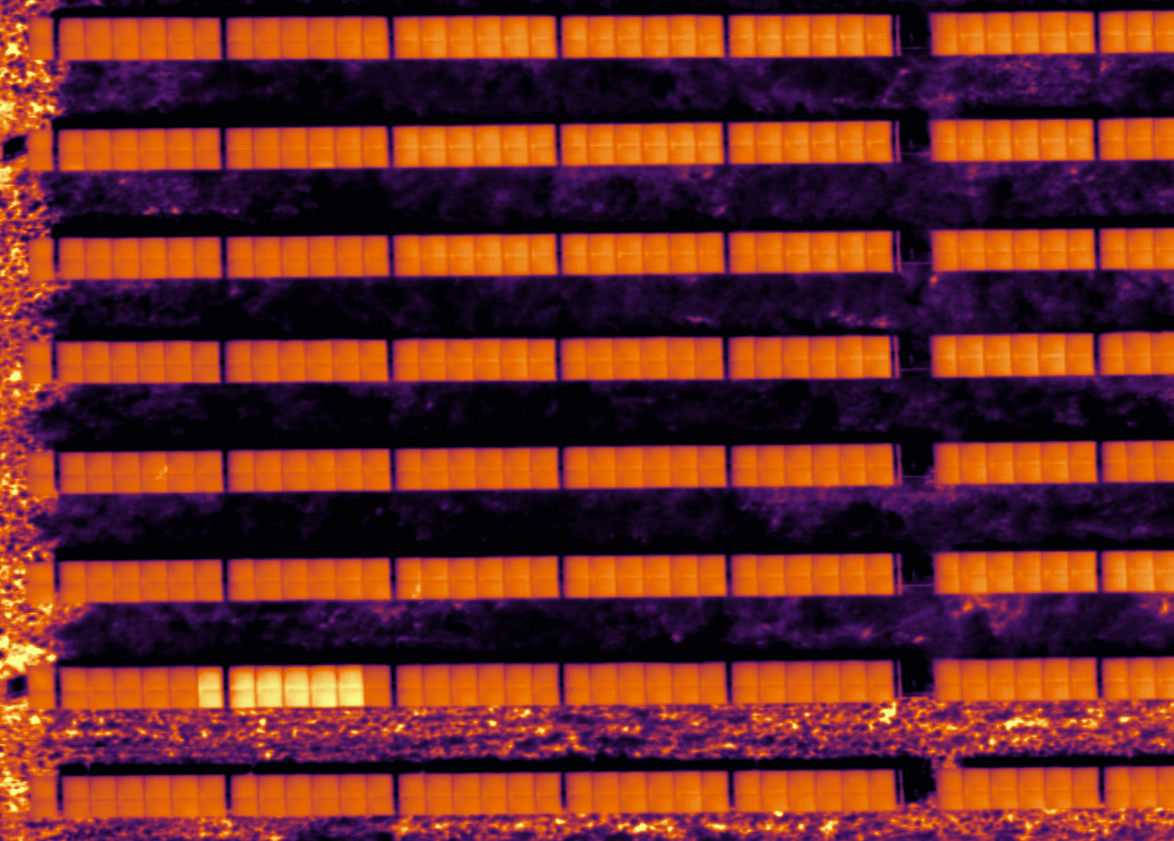Can Drone Thermography Really Work on Thin-Film Modules?
It’s a question we still hear from asset managers and operators:
Can drone-based thermography deliver reliable insights on thin-film PV modules?
The short answer: yes. But only with adapted methodology. Thin-film modules have distinct thermal behavior, so inspections must be more nuanced, use higher resolution, and lean on complementary validation.

Why Thin-Film Modules Pose Unique Thermal Challenges
- They tend to run hotter by design, making anomalies harder to isolate against the baseline.
- Their heating is more uniform, so subtle defects don’t “pop out” in the same way as in crystalline modules.
- Hotspots tend to be less intense, demanding finer spatial resolution to detect them reliably.
In practice, measurement error can introduce large deviations. Module temperature readings can deviate by up to 14.8 °C when thermography is not precisely calibrated, translating to ±6–7 % error in DC output estimates in some cases.
These inherent challenges explain why, historically, many operators abandoned drone inspections of thin-film sites, the data was too ambiguous.

What the Field & Literature Teach Us
1. Drones vs aircraft — accuracy, scale, trade-offs
A recent study highlighted research from the University of Genoa comparing UAV-mounted thermography with manned aircraft imaging. The results were striking:
- ~99.6% agreement in detecting major defects like string outages and module faults.
- Drones captured ~98% of thermal anomalies identified by aircraft, with only a negligible 0.23 K temperature delta.
In other words, drones deliver results that are virtually identical in accuracy to large-scale aerial surveys, but with far greater flexibility, site accessibility, and integration into asset management workflows.
While manned aircraft may appear efficient for extremely large utility plants, they lack the adaptability and frequency of inspection that drones enable. For asset managers seeking regular, high-resolution, and actionable insights, UAV-based thermography is the practical choice.
How We Adapt at Sitemark
Drawing both from literature and field feedback, here’s how we approach thin-film inspections:
- Combine high-resolution thermography and visual/EL imaging
- Thermal methods alone may miss microcracks or subtle delamination. EL helps validate and uncover what IR cannot.
- Push for at least 3 cm/px GSD (or better) in thermal imagery
- Especially for thin-film, you need enough spatial fidelity to catch the mild hotspots that matter.
- Focus on actionable insights, not just images
- Rather than delivering a heat map, we aim to flag modules or zones for targeted technician follow-up.
- Be aware of scale trade-offs
- For very large thin-film plants, it may make sense to mix drone inspections for detailed zones and aerial platforms for baseline coverage.
Thin-film won’t map exactly like crystalline silicon does, but with the right setup, you can detect both big, critical defects and subtle early warnings.
We’ve compiled our field learnings and data-backed practices into a Drone Thermography Best Practices Guide, covering:
- Optimal flight parameters and GSD targets for different module types
- Common interpretation pitfalls (and how to avoid them)
- How to combine RGB, thermal, and EL data for maximum accuracy
- Calibration and validation workflows used in professional inspections
Download the guide to benchmark your inspection setup and improve accuracy across all module types.
Key Takeaways
- Drone thermography can be effective on thin-film modules, but only when adapted to the technology’s properties.
- The best results come when thermal data is validated with EL and visual imagery.
- For very large assets, aerial inspection may rival drones in cost-efficiency.
- The industry still lacks robust thin-film–specific standards, so practitioners must remain vigilant in interpreting results.
FAQ: Drone Thermography on Thin-Film Modules
Can drone thermography really detect defects in thin-film solar modules?
Yes, but with limitations. Thin-film modules heat more uniformly and run hotter by design, so anomalies are less obvious than in crystalline modules. High-resolution thermal imaging (3 cm/px GSD or better), paired with RGB or EL imaging, is needed for actionable results.
What resolution is recommended for thin-film thermography?
We recommend 3 cm/px or better for thermal imagery. However, many practitioners argue that higher-resolution RGB imagery is even more critical for spotting issues like delamination, adhesion problems, or glass breakage.
Can drones replace technicians for thin-film inspections?
Not yet. Drone thermography is a powerful screening tool, but field technicians are still needed for follow-up diagnostics and repairs. Current IEC inspection standards were written for silicon modules, so thin-film inspections require extra interpretation.
What are the advantages of combining thermography with electroluminescence (EL)?
EL can reveal defects invisible to IR, such as microcracks or early degradation. Drone-based EL can cut inspection costs by up to 20× compared to ground-based methods, while covering much larger areas efficiently.
Is drone inspection cost-effective for large thin-film sites?
For medium-sized plants, drones are efficient and accurate. But PV Magazine notes that for very large sites requiring multiple days of UAV coverage, aircraft-mounted thermal imaging may become more cost-effective while maintaining ~99.6% detection accuracy.
Ready to Level Up Your Drone Thermography?
Ready to see how advanced thermography can work on your solar assets?
Book a short demo with our team — we’ll walk you through how Sitemark:
- Detects subtle thermal anomalies in thin-film and crystalline modules
- Combines thermal, RGB, and EL data for higher accuracy
- Helps you make faster, data-driven maintenance decisions


